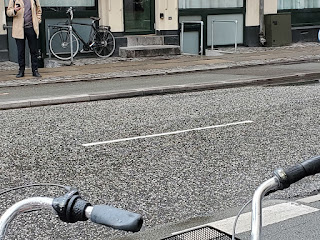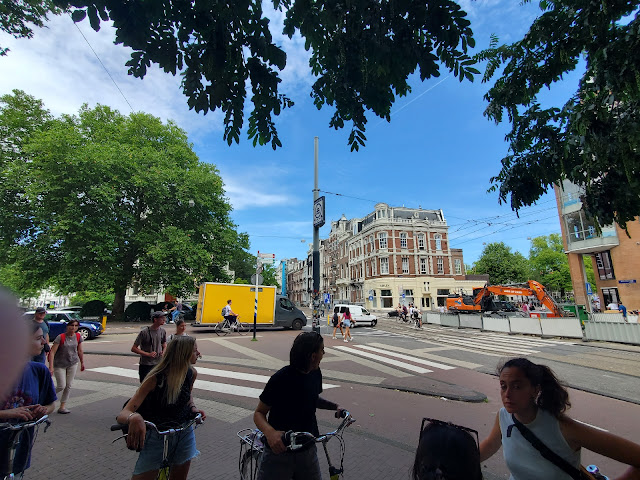On the last day in Copenhagen, we were tasked with another
scavenger hunt. This time, we searched for particular types of bicycle
supportive infrastructure. The most visible examples include the curb assists
that allow bicyclists to transition from the road into a cycle track. And of
course, the cycle track itself.
 |
| A protected cycle track in Copenhagen |
Elements of many intersections in Copenhagen include designating where the bicycle lane continues after the cycle track transitions into the intersection. Naturally, the road must remain accessible for cars to travel through, so the cycle track segment must end when one enters an intersection. So, blue paint identifies for both bicyclists and drivers where the bike lane continues through the intersection, giving bicyclists certainty in where to be and drivers certainty of where the biking traffic will be, especially those making a left or right turn through the intersection. As I noted from the previous blog post, earlier in the day during the bike tour, James of Copehagenize mentioned that blue paint performed well to communicate the traffic flow to all commuters, compared to red paint. I noticed that bus-only lanes in some parts of the city utilized red-painted lanes however and wondered if that also served to enhance the contrast between bus space and bike space.
 |
Use of blue paint to designate a bike lane
through the four-way intersection |
In addition to the road infrastructure, one also sees different types of bikes on the road allowing the user different functions. The common passenger bike functions well to transport people as we think of with typical commuters. Often though, one might see a small basket on the front of the passenger bikes providing some storage space for backpacks or handbags, but also other items such as groceries or even pets. There are also many types of cargo bikes used throughout the city. Some bikes are two-wheeled while others are three-wheeled, enabling biking transport for a variety of abilities and preferences. Most often I observed the container installed on the front of the bike, carrying anything from consumer goods, bags, small children, and adults. On other cargo bikes, the storage area exists on the back of the bike. These cargo bikes appeared to be most used by people acting as couriers, transporting larger boxes of goods, or even pulling what appeared to be a cart that they would set up as mobile food shops to make a mobile business move through different parts of the city.
 |
Curb assist for bikes to enter cycle track
|
 
|
(Left) A smoothed pavement to assist bicyclists riding on the cobblestone;
(Right) A woman attends a cultural performance with her dog resting comfortably in a cargo bike |








Comments
Post a Comment